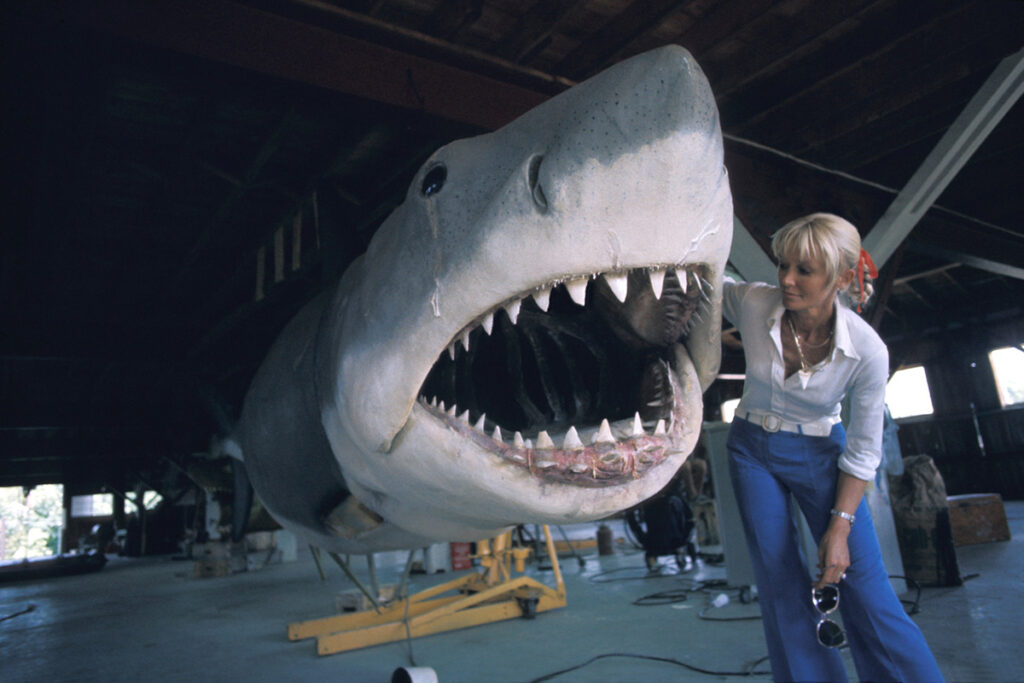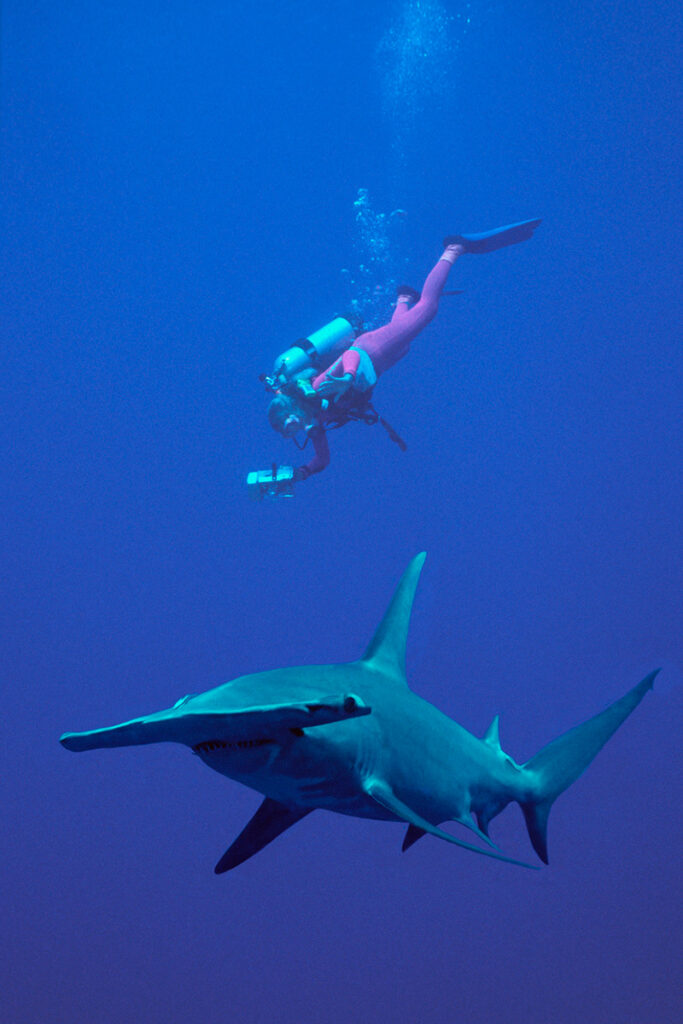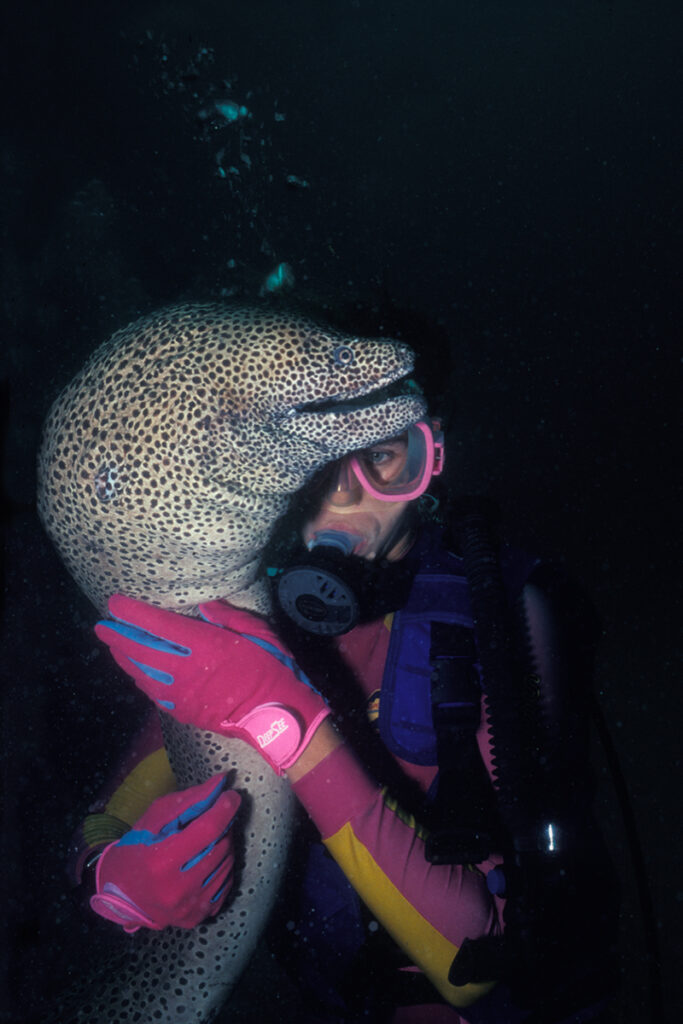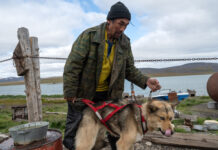After participating in the shoot that led to Hollywood’s most famous shark scene, Valerie Taylor became a tireless defender of sharks and the marine environment. For ADEX Pixel Expo’s “Generational Exchange”, actress and ADEX Ambassador for Marine Conservation Hidy Yu talks to the Australian legend
Everybody, it seems, wants to be frightened of something. We don’t have witches and devils anymore, but we have the great white shark. – Valerie Taylor
It was the movie aggrieved crew members nicknamed “Flaws”, such were the difficulties with the shoot, from bad weather and seasickness to waterlogged cameras. Famously, its producers initially thought the film’s star – a great white shark – could be trained. When it became apparent that this was not the case, effects technicians constructed three pneumatically powered prop sharks, which would repeatedly malfunction. Its young director, Steven Spielberg, realised he would need some great footage of real sharks to save the film.
On the other side of the world, in Australia, underwater filmmaking couple Valerie and Ron Taylor had already established an enthusiastic following in their home country. Valerie’s mother had encouraged her to do anything she wanted, and on her 15th birthday, she left school to get a job. After trying her hand at different things – artist, actress, model, comic strip illustrator – she started diving. She met Ron at a dive club and they started working together.
In time, Ron and Valerie’s pioneering films exploring the underwater world would be beamed into living rooms across the country. Ron, the trailblazing filmmaker, captured the teeming reefs using cameras in homemade housings; Valerie, the blond-haired adventurer in her trademark pink wetsuit, lent their documentaries a touch of glamour. The corals were beautiful, but from the beginning, it was clear that what audiences really wanted was excitement and danger. “When we first started in 1958, the only thing we could sell was shark footage,” recalls Valerie, now 87. “We could get on television anytime we wanted with a good shark story and footage.”

When Hollywood came knocking, Ron and Valerie leapt at the chance. “We read the book [Peter Benchley’s novel] and we decided that
we could shoot the great white shark,” remembers Valerie. “We thought it would be a very good job for my husband and myself, and there’d be money in it.”
While the great whites in Australia were around four or five metres long, the shark in Benchley’s book was nine metres. So, along with a shot list and an assistant director, the producers sent, as Valerie puts it, “a half-size shark cage and a half-size stuntman”.
The problem was that the stuntman was terrified and wouldn’t get in the cage. “A nice fella, he was a big sook,” says Valerie, using Australian slang for a person lacking courage. “He couldn’t go in the sun. He was allergic to salt spray. He was allergic to sharks. And he couldn’t dive. He wouldn’t get in the cage. He was terrified.” Then a big great white showed up. The shark got entangled in the cable attached to the winch on the stuntman’s cage and started thrashed around wildly, breaking the winch and destroying the shark cage. “Ron was underwater and he was filming up. There was so much movement and thrashing around you couldn’t see the [stunt] double wasn’t there. He wasn’t there: He was almost unconscious with fear on the stunt boat!”
Spielberg was so enamoured with Ron’s dramatic footage that the decision was taken to alter the climactic action scene with the Richard Dreyfuss character Matt Hooper in the shark cage. Following Benchley’s novel, the script originally had Hooper being killed by the shark. To allow the footage to be used, the script was changed to have Hooper escape from the cage instead.

UNDOING THE DAMAGE
Like many people that began diving in the 50s and 60s, Valerie and Ron shared a love for spearfishing. “My husband was the best in the world,” Valerie says matter-of-factly. “And I was the best woman in Australia.” But in just a few years, the pair noticed that the fish were vanishing. There were fewer fish, especially bigger fish like sharks. Ron and Valerie made a decision to leave the spearfishing scene: They went from champion spearfishers to championing sharks.
After Jaws unexpectedly became a massive blockbuster hit in 1975, Valerie and Ron soon realised that their fictional shark had stoked very real fear and hatred. There was a reported rise in the popularity of recreational shark hunting. “It caused a lot of problems, with men going out [on the water] and saying, ‘We’re very big and brave’, and killing sharks,” laments Valerie. “They didn’t care what sort. It could be the most harmless shark in the world. But they just did it. It was extremely upsetting.”

The reality, of course, is that only a few of the hundreds of species of sharks are known to bite humans. They’re not trying to eat us so much as figure us out. “They don’t have hands, so they feel with their teeth,” says Valerie. “If you’re ever in the water with a shark, stay still. If you thrash around and start screaming, you’re acting like a wounded fish.”
Valerie says in all the time she’s filmed sharks in different parts of the world, she’s only been bitten four times, and only once where she needed surgery. The sharks that bit her were blue sharks, which are found in the open ocean. The same goes for “the most dangerous shark in the world”, the oceanic whitetip. “It’s killed hundreds and hundreds of people in shipwrecks and in downed aeroplanes, especially during the war, but it only lives in the open ocean. It never comes into the beaches, so we don’t have to worry about it when swimming.
Jaws had exposed a great lack of understanding about sharks among the public. Universal Pictures, which jointly produced and distributed the film, took the unusual step of flying Ron and Valerie to the United States to educate people about sharks on the country’s talk shows. “My husband used to say on camera, when we were doing the interviews, ‘You don’t go to New York and expect to see King Kong on the Empire State Building.’” He would explain that you shouldn’t expect to see a massive great white when you go swimming at the beach either. “It was a fictitious shark, a pretend shark,” says Valerie. “But everybody, it seems, wants to be frightened of something. We don’t have witches and devils anymore, but we have the great white shark.”

IN DEFENCE OF SHARKS
Valerie has spent the rest of her life advocating for sharks. In the mid-1980s, when the grey nurse shark became the very first protected shark species in the world, she and Ron were at the centre of the campaign. Later, they helped gain protections for one of the Great Barrier Reef ’s icons: the potato cod. Following Ron’s death from leukaemia in 2012, Valerie has continued passionately advocating for a variety of marine creatures. Today, she’s still fighting for the removal of shark nets from New South Wales and Queensland beaches.

“We’ve become more and more sophisticated in how we catch fish and eventually there’ll be no more fish,” asserts Valerie. “Even the great white is becoming scarce. Unfortunately, its jaws are worth many thousands of dollars – Americans and Japanese buy them. However, in Australia, it’s protected. You’re not supposed to kill them but the fishermen take them as bycatch, which isn’t right but that’s what happens.”
As she approaches her ninth decade, Valerie is ready for the new generation of conservationists to continue the fight, but she’s not optimistic. “I’ve had my day. I’ve got no complaints, except people won’t listen to me. They don’t want to listen, especially fishermen,” she says. “The human race is greedy. They will not stop fishing. They will take the last tuna. It’s just going to happen.”
“Young girls come to me sometimes wanting advice,” Valerie continues. “I always say: Go out there and do what you want to do as long as it’s for the betterment of the planet, even if it’s just walking along the water and picking up cigarette butts and plastic.” But she thinks young people don’t need any advice to inspire them to take action and protect our oceans. “I don’t think I have to give them any reason,” Valerie says emphatically. “I think the new generation is going to know. They’re going to understand it without me telling them.”

*AG
Images Valerie Taylor
For more stories from this issue, get a copy of Asian Geographic No.159 or subscribe at https://shop.asiangeo.com











